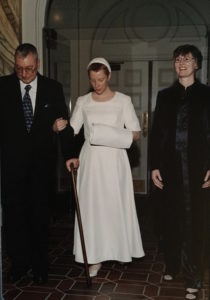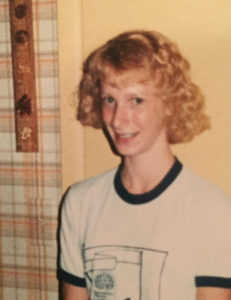I grew up in a makerspace. My mom was, and still is, a maker. Left to her own devices and ingenuity, she makes things. Lots of moms do, and dads too, and plenty of other random people, but I grew up with my mom and dad and this is my essay. Everything here is filtered through my memory and my feelings, so ties to objective reality are tenuous, but you’ll get the gist, and it’s pretty close to correct. I think.
My mom’s approach to a problem, or really anything even if it’s not a problem at all, is: “I can solve that. Let me think about it, find some instructions, get the right tools, and work carefully. I can do this!”
My remembrance of growing up in the 1970s and 1980s was a series of my mom getting the needed instructions and equipment, figuring out how to do it, and then making stuff (or making stuff happen). Macrame trend? Mom got yarn, and glue, and a book, and we had a hanging plant holder. Crewel embroidery? Sure! But Mom quickly tired of following packaged patterns, so she’d figure out how to transform something I drew, or a picture I liked out of a coloring book, into wall art. Everybody’s crocheting an afghan? No problem: a book, some hooks, some great yarn, and we still have the afghan she made. It’s fabulously warm and has held up beautifully. Altra luggage kits? I still have the garment bag, tote bag, and dopp kit she made. They work great.

Ballerina Barbie coloring book image, rendered by my mom in crewel embroidery.
I went away to college. I called home: “Mom, it’s COLD here.” The first stop on my next trip home was the chain fabric store, just for patterns (it’s hard to get great fabric at a chain store). I found the pattern I loved (ankle-length, with slash pockets and raglan sleeves). Next stop: a fabric store in a mobile home, where they had gorgeous remnants and remainders and who knows what all, where we bought yards of stunning, thick, teal wool. I went back to college leaving my mother to find and procure this amazing lining fabric that was windproof on one side and satin-y on the other (making the coat easier to put on and off, and warm like Thinsulate but with even less bulk). Perfectly matched buttons? You bet! Add an inside pocket that’s not on the pattern? Of course! I wore that coat all the time, including one night I spent standing outside the bus station in Lynchburg, Virginia, watching the temperature drop from 43F to 23F, waiting for a bus that was 5 hours late. I live in Florida now, but I still have the coat.
I loved going to the fabric store as a child: I could pick any pattern I wanted, even if it was marked “plus difficile” in the Vogue pattern catalog. I learned really early how to understand what fabric would work for what design. And there was never a problem if I couldn’t find a pattern for exactly what I wanted: we could buy different patterns for different features and my mom could make them come together. If I wanted Those Sleeves on That Bodice with a Different Skirt, my mom would help me evaluate the plausibility of how they’d work together and then she’d just… do it.
My mom’s college degrees and avocation (as surely you’ve noted) are in clothing and textiles. She made her own wedding gown, and she made mine. We were in NYC in July 2001 to visit the Jackie Kennedy exhibit at the Met, and I saw some unusually-set sleeves: “Mom, can you…?” Sure! We went to the garment district and bought cream-colored velvet and she designed the dress (including those fabulous sleeves), made me a muff to carry, and turned her attention to millinery to duplicate the design and construction of a velvet cap I found in a thrift store. Ta-da! A flower-hating, crew-cut, February-in-the-midwest bride.

I was happy and lucky to have both parents walk me down the aisle.
And it wasn’t magic (she can do magic, don’t get me wrong: she can balance a Barbie doll standing on its own two feet with no support) — it was skill, and work, and perseverance, and willingness to re-do and re-do as needed. Speaking of Barbies, though, and weddings…if I wanted a white dotted swiss bride gown for Ballerina Barbie and a pink dotted swiss bridesmaid gown for Fashion Photo PJ, lucky me, because mom would buy the pattern (yes, Barbie dress patterns), rootle through her scrap bag, and sew up some eyelet-trimmed dotted swiss bridal wear. With matching headwear.
Having a house to decorate and maintain let Mom expand her skills substantially. Patterned wallpaper in the 1970s? SURE. Mom bought this fabulous booklet at Wallpaper Warehouse in Bridgeville, PA, for 50 cents. Take a look: I scanned the thing (although not very well, sorry, and PLEASE check out how self-efficacious the woman in the booklet is). As a result, we had wallpapered rooms where the patterns matched exactly at every seam and lined up perfectly around every switch plate and outlet cover. Want ceramic tile to replace the old vinyl flooring in the powder room, and a tiled backsplash in the kitchen? No problem. Buy a book, buy the equipment, and we had tiled surfaces that impressed even the contractor who did the kitchen remodel (yeesh, even my mom drew the line at in-depth kitchen cabinetry and serious plumbing, although she did cedar-line a closet once).

Don’t look at me having just had my wisdom teeth removed; look at the outlet/switch plate.
I didn’t learn patience and perseverance and resilience and creativity from all this, but I should have…well, maybe I did, a little: I never sit down to sew without having a REALLY GOOD seam ripper at hand — I know it’s almost always better to re-do it if it’s wrong, and trying to cover up a mistake rather than acknowledging it and fixing it is a recipe for disaster. I also know that, from the fun of picking out a pattern and buying gorgeous fabric, there are MANY steps of prep that are easy to skip…if you want to produce something terrible.
Yes, it’s hard on an impatient kid to cut the pattern pieces, press them flat with a warm iron, pre-shrink the fabric, straighten the fabric, fold everything correctly so the grain of the fabric is lined up, pin the pattern carefully and following the layout directions (yes, including the eons it will take you to match the patterns on a figured fabric!), cut slowly and carefully including the notches you’ll later use to line up the pieces, and use a pencil or washable marker to mark every line and dot. If you don’t do all that, you’ll still put in a lot of time, but wind up with a product that isn’t very good.
Anyway, since I am by nature an incredibly lazy person, I don’t have the maker urge. Thanks to my mom, though, I CAN make things, and I know how to learn how to fix, or make, a new thing, and I occasionally even do so. When my kid’s wizard costume for halloween — yes, we bought it, although when I was a kid NEEDLESS TO SAY I never had a bought costume — was too long, I got a needle and matching thread and I hemmed it. (And wouldn’t you know I can still do a completely invisible hand-hem?) When the turn signal bulb on my car burned out, I found some YouTube videos, got out my socket set, identified and bought the correct bulb, and changed it. But I’m not the real maker in my house — I know a good characteristic when I see it, and my dear husband works very much like my mother does. How would we make a removable and reusable PVC-pipe-and-bird-netting cage for our blueberry patch? Let’s just say we have one now. It works great.

I made the dried-bean wall hanging…well, yeah, I did, but LOOK AT THE SWITCH PLATE COVER. LOOK AT IT!




